Inventory System Design: Data Structures and Algorithms Report
VerifiedAdded on 2022/10/14
|11
|2568
|8
Report
AI Summary
This report details the design of an inventory system for a company dealing with household and food items. It outlines the variables, keys, and ranges for product data, including unique IDs, names, prices, and manufacturers, with specific data types and ranges. The report discusses the operations the inventory will support, such as sorting, insertion, deletion, searching, and updating products. It then explores the algorithms required for these operations, including bubble sort for sorting, balanced binary search trees for insertion and deletion, and linear search for product retrieval. The report also addresses the changes needed for a larger system, recommending merge sort for efficient sorting and binary search for product searches. The design includes considerations for a merged company with a significantly larger product inventory, demonstrating a comprehensive approach to inventory management using data structures and algorithms.
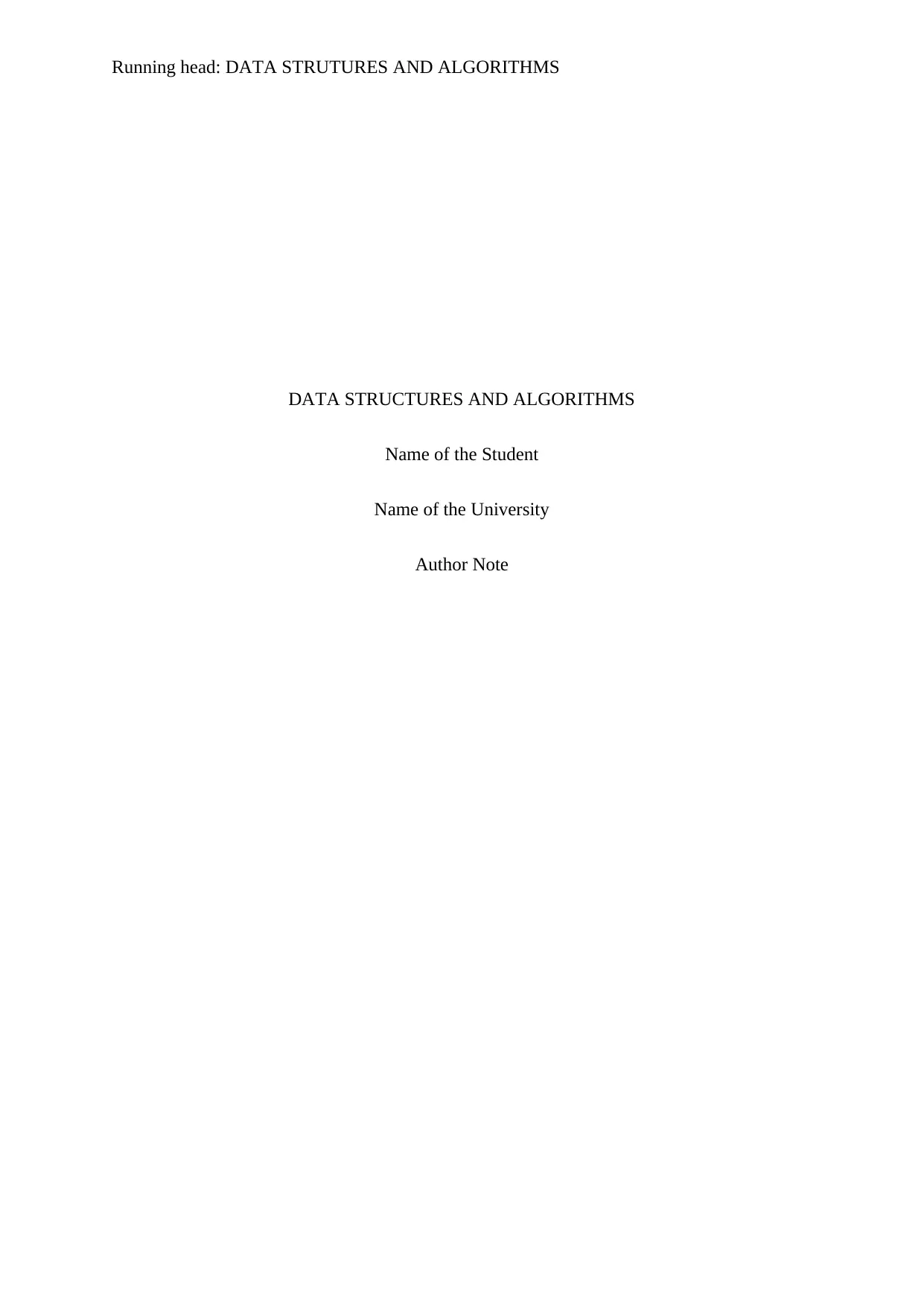
Running head: DATA STRUTURES AND ALGORITHMS
DATA STRUCTURES AND ALGORITHMS
Name of the Student
Name of the University
Author Note
DATA STRUCTURES AND ALGORITHMS
Name of the Student
Name of the University
Author Note
Paraphrase This Document
Need a fresh take? Get an instant paraphrase of this document with our AI Paraphraser

1DATA STRUCTURES AND ALGORITHMS
Executive Summary
The inventory appears to be an essential strength of a business as the inventory turnover
represents one of the sources of generation of revenue that are primary and the earnings that
are subsequent for the stakeholders of the company. The report deals with the designing of an
inventory system for the organization. The report focuses on the keys, ranges and the
variables that are to be used in the inventory system. The report discusses about the
operations that are to be supported by the inventory system. The report has a detailed
discussion about the algorithms that the inventory system should support. Lastly, the changes
that could be brought in a larger inventory system.
Executive Summary
The inventory appears to be an essential strength of a business as the inventory turnover
represents one of the sources of generation of revenue that are primary and the earnings that
are subsequent for the stakeholders of the company. The report deals with the designing of an
inventory system for the organization. The report focuses on the keys, ranges and the
variables that are to be used in the inventory system. The report discusses about the
operations that are to be supported by the inventory system. The report has a detailed
discussion about the algorithms that the inventory system should support. Lastly, the changes
that could be brought in a larger inventory system.

2DATA STRUCTURES AND ALGORITHMS
Table of Contents
Introduction:...............................................................................................................................3
Discussions.................................................................................................................................3
Case Study Scenario...............................................................................................................3
Variables, Keys and Ranges...................................................................................................3
Operations the Inventory will support....................................................................................5
Algorithms for operations......................................................................................................6
Changes for larger system......................................................................................................8
Conclusion..................................................................................................................................9
References................................................................................................................................10
Table of Contents
Introduction:...............................................................................................................................3
Discussions.................................................................................................................................3
Case Study Scenario...............................................................................................................3
Variables, Keys and Ranges...................................................................................................3
Operations the Inventory will support....................................................................................5
Algorithms for operations......................................................................................................6
Changes for larger system......................................................................................................8
Conclusion..................................................................................................................................9
References................................................................................................................................10
⊘ This is a preview!⊘
Do you want full access?
Subscribe today to unlock all pages.

Trusted by 1+ million students worldwide
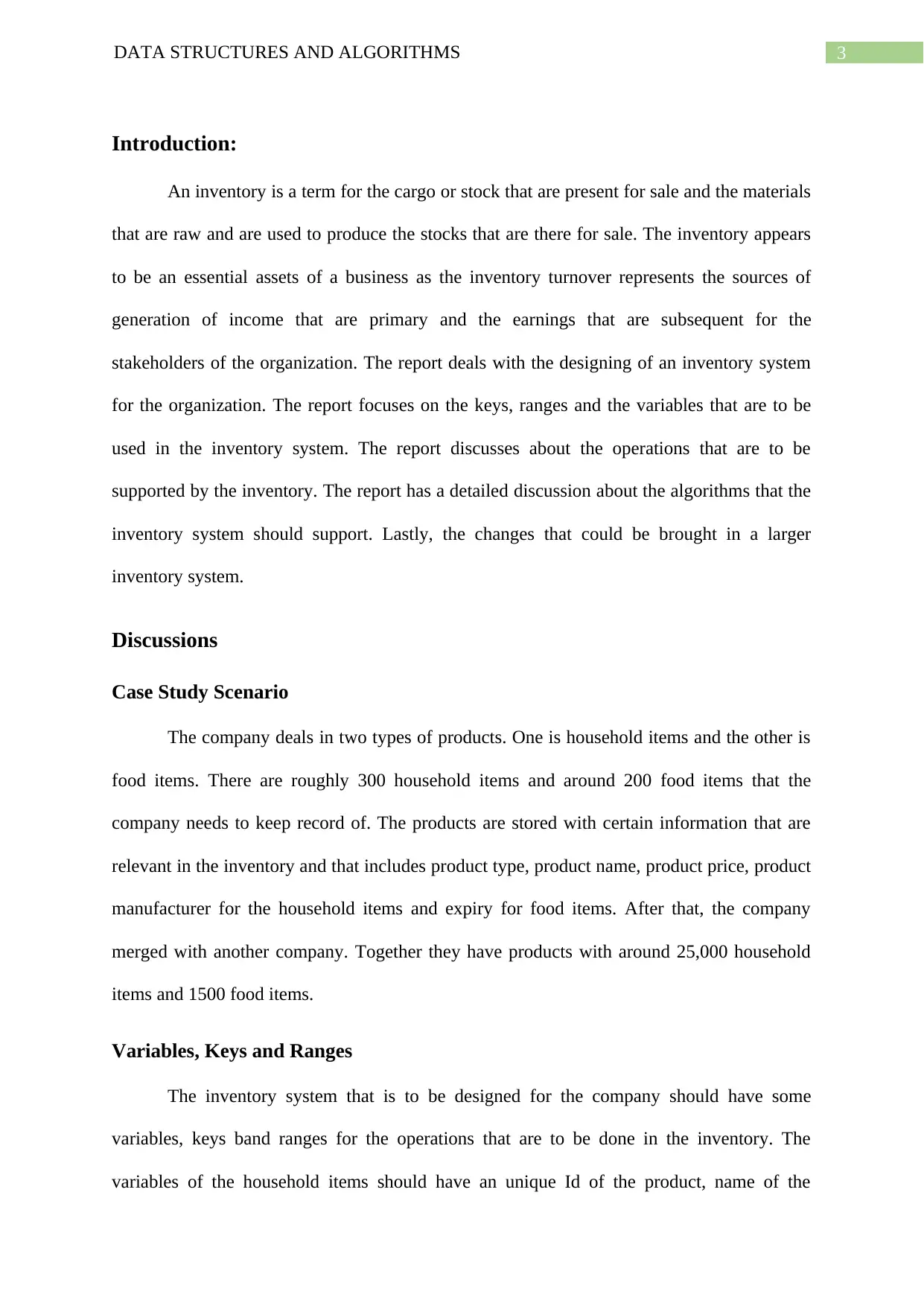
3DATA STRUCTURES AND ALGORITHMS
Introduction:
An inventory is a term for the cargo or stock that are present for sale and the materials
that are raw and are used to produce the stocks that are there for sale. The inventory appears
to be an essential assets of a business as the inventory turnover represents the sources of
generation of income that are primary and the earnings that are subsequent for the
stakeholders of the organization. The report deals with the designing of an inventory system
for the organization. The report focuses on the keys, ranges and the variables that are to be
used in the inventory system. The report discusses about the operations that are to be
supported by the inventory. The report has a detailed discussion about the algorithms that the
inventory system should support. Lastly, the changes that could be brought in a larger
inventory system.
Discussions
Case Study Scenario
The company deals in two types of products. One is household items and the other is
food items. There are roughly 300 household items and around 200 food items that the
company needs to keep record of. The products are stored with certain information that are
relevant in the inventory and that includes product type, product name, product price, product
manufacturer for the household items and expiry for food items. After that, the company
merged with another company. Together they have products with around 25,000 household
items and 1500 food items.
Variables, Keys and Ranges
The inventory system that is to be designed for the company should have some
variables, keys band ranges for the operations that are to be done in the inventory. The
variables of the household items should have an unique Id of the product, name of the
Introduction:
An inventory is a term for the cargo or stock that are present for sale and the materials
that are raw and are used to produce the stocks that are there for sale. The inventory appears
to be an essential assets of a business as the inventory turnover represents the sources of
generation of income that are primary and the earnings that are subsequent for the
stakeholders of the organization. The report deals with the designing of an inventory system
for the organization. The report focuses on the keys, ranges and the variables that are to be
used in the inventory system. The report discusses about the operations that are to be
supported by the inventory. The report has a detailed discussion about the algorithms that the
inventory system should support. Lastly, the changes that could be brought in a larger
inventory system.
Discussions
Case Study Scenario
The company deals in two types of products. One is household items and the other is
food items. There are roughly 300 household items and around 200 food items that the
company needs to keep record of. The products are stored with certain information that are
relevant in the inventory and that includes product type, product name, product price, product
manufacturer for the household items and expiry for food items. After that, the company
merged with another company. Together they have products with around 25,000 household
items and 1500 food items.
Variables, Keys and Ranges
The inventory system that is to be designed for the company should have some
variables, keys band ranges for the operations that are to be done in the inventory. The
variables of the household items should have an unique Id of the product, name of the
Paraphrase This Document
Need a fresh take? Get an instant paraphrase of this document with our AI Paraphraser
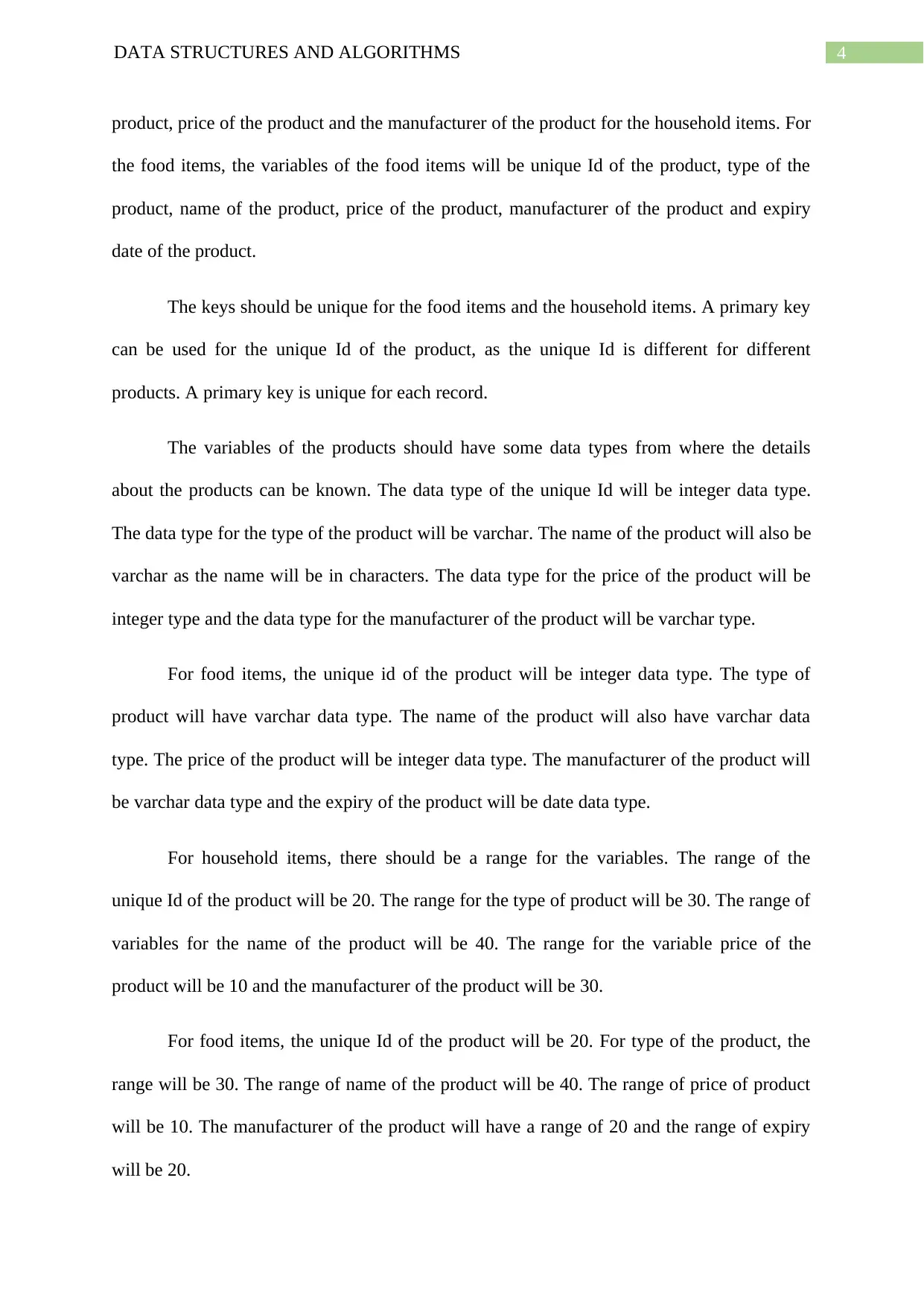
4DATA STRUCTURES AND ALGORITHMS
product, price of the product and the manufacturer of the product for the household items. For
the food items, the variables of the food items will be unique Id of the product, type of the
product, name of the product, price of the product, manufacturer of the product and expiry
date of the product.
The keys should be unique for the food items and the household items. A primary key
can be used for the unique Id of the product, as the unique Id is different for different
products. A primary key is unique for each record.
The variables of the products should have some data types from where the details
about the products can be known. The data type of the unique Id will be integer data type.
The data type for the type of the product will be varchar. The name of the product will also be
varchar as the name will be in characters. The data type for the price of the product will be
integer type and the data type for the manufacturer of the product will be varchar type.
For food items, the unique id of the product will be integer data type. The type of
product will have varchar data type. The name of the product will also have varchar data
type. The price of the product will be integer data type. The manufacturer of the product will
be varchar data type and the expiry of the product will be date data type.
For household items, there should be a range for the variables. The range of the
unique Id of the product will be 20. The range for the type of product will be 30. The range of
variables for the name of the product will be 40. The range for the variable price of the
product will be 10 and the manufacturer of the product will be 30.
For food items, the unique Id of the product will be 20. For type of the product, the
range will be 30. The range of name of the product will be 40. The range of price of product
will be 10. The manufacturer of the product will have a range of 20 and the range of expiry
will be 20.
product, price of the product and the manufacturer of the product for the household items. For
the food items, the variables of the food items will be unique Id of the product, type of the
product, name of the product, price of the product, manufacturer of the product and expiry
date of the product.
The keys should be unique for the food items and the household items. A primary key
can be used for the unique Id of the product, as the unique Id is different for different
products. A primary key is unique for each record.
The variables of the products should have some data types from where the details
about the products can be known. The data type of the unique Id will be integer data type.
The data type for the type of the product will be varchar. The name of the product will also be
varchar as the name will be in characters. The data type for the price of the product will be
integer type and the data type for the manufacturer of the product will be varchar type.
For food items, the unique id of the product will be integer data type. The type of
product will have varchar data type. The name of the product will also have varchar data
type. The price of the product will be integer data type. The manufacturer of the product will
be varchar data type and the expiry of the product will be date data type.
For household items, there should be a range for the variables. The range of the
unique Id of the product will be 20. The range for the type of product will be 30. The range of
variables for the name of the product will be 40. The range for the variable price of the
product will be 10 and the manufacturer of the product will be 30.
For food items, the unique Id of the product will be 20. For type of the product, the
range will be 30. The range of name of the product will be 40. The range of price of product
will be 10. The manufacturer of the product will have a range of 20 and the range of expiry
will be 20.
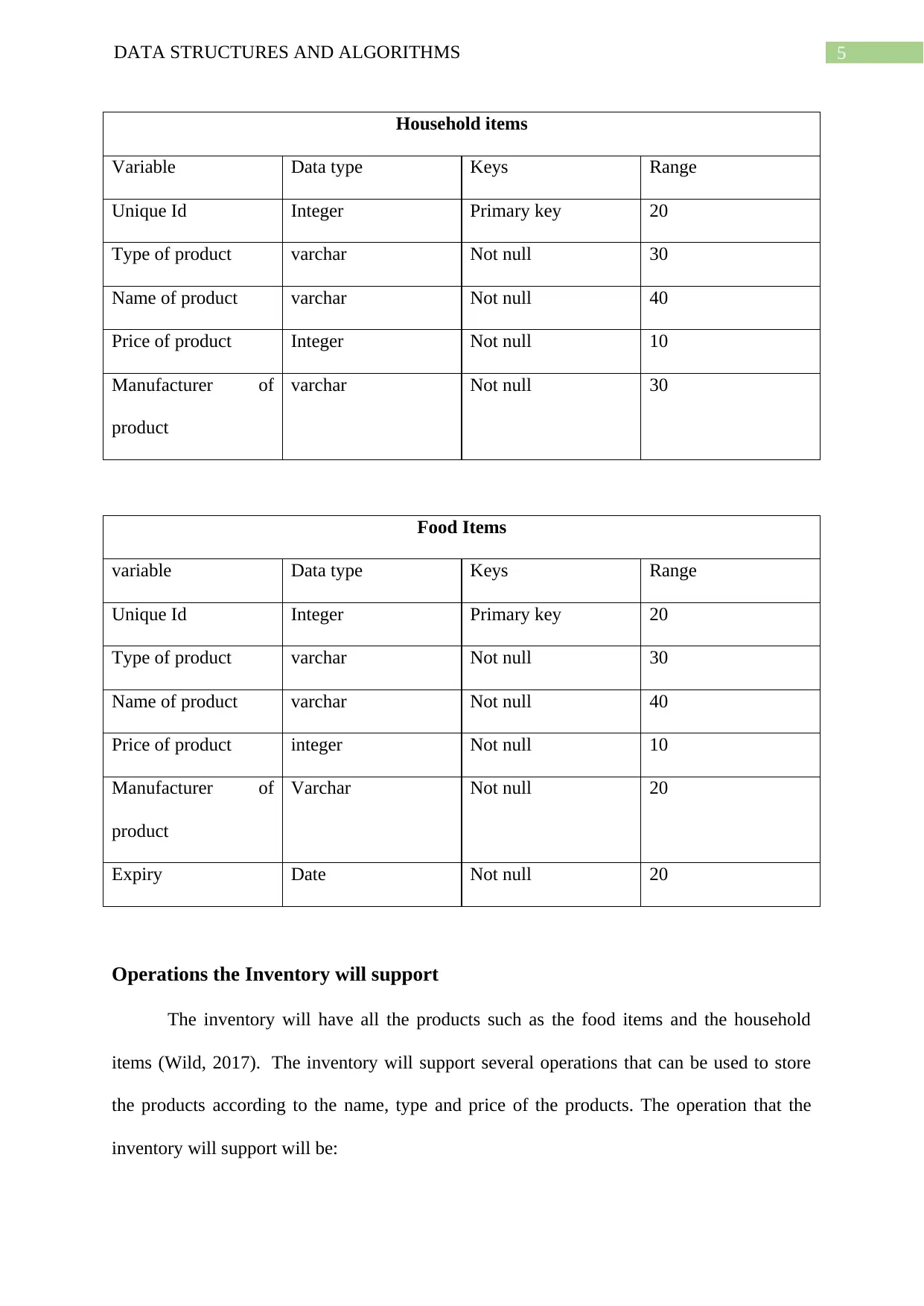
5DATA STRUCTURES AND ALGORITHMS
Household items
Variable Data type Keys Range
Unique Id Integer Primary key 20
Type of product varchar Not null 30
Name of product varchar Not null 40
Price of product Integer Not null 10
Manufacturer of
product
varchar Not null 30
Food Items
variable Data type Keys Range
Unique Id Integer Primary key 20
Type of product varchar Not null 30
Name of product varchar Not null 40
Price of product integer Not null 10
Manufacturer of
product
Varchar Not null 20
Expiry Date Not null 20
Operations the Inventory will support
The inventory will have all the products such as the food items and the household
items (Wild, 2017). The inventory will support several operations that can be used to store
the products according to the name, type and price of the products. The operation that the
inventory will support will be:
Household items
Variable Data type Keys Range
Unique Id Integer Primary key 20
Type of product varchar Not null 30
Name of product varchar Not null 40
Price of product Integer Not null 10
Manufacturer of
product
varchar Not null 30
Food Items
variable Data type Keys Range
Unique Id Integer Primary key 20
Type of product varchar Not null 30
Name of product varchar Not null 40
Price of product integer Not null 10
Manufacturer of
product
Varchar Not null 20
Expiry Date Not null 20
Operations the Inventory will support
The inventory will have all the products such as the food items and the household
items (Wild, 2017). The inventory will support several operations that can be used to store
the products according to the name, type and price of the products. The operation that the
inventory will support will be:
⊘ This is a preview!⊘
Do you want full access?
Subscribe today to unlock all pages.

Trusted by 1+ million students worldwide
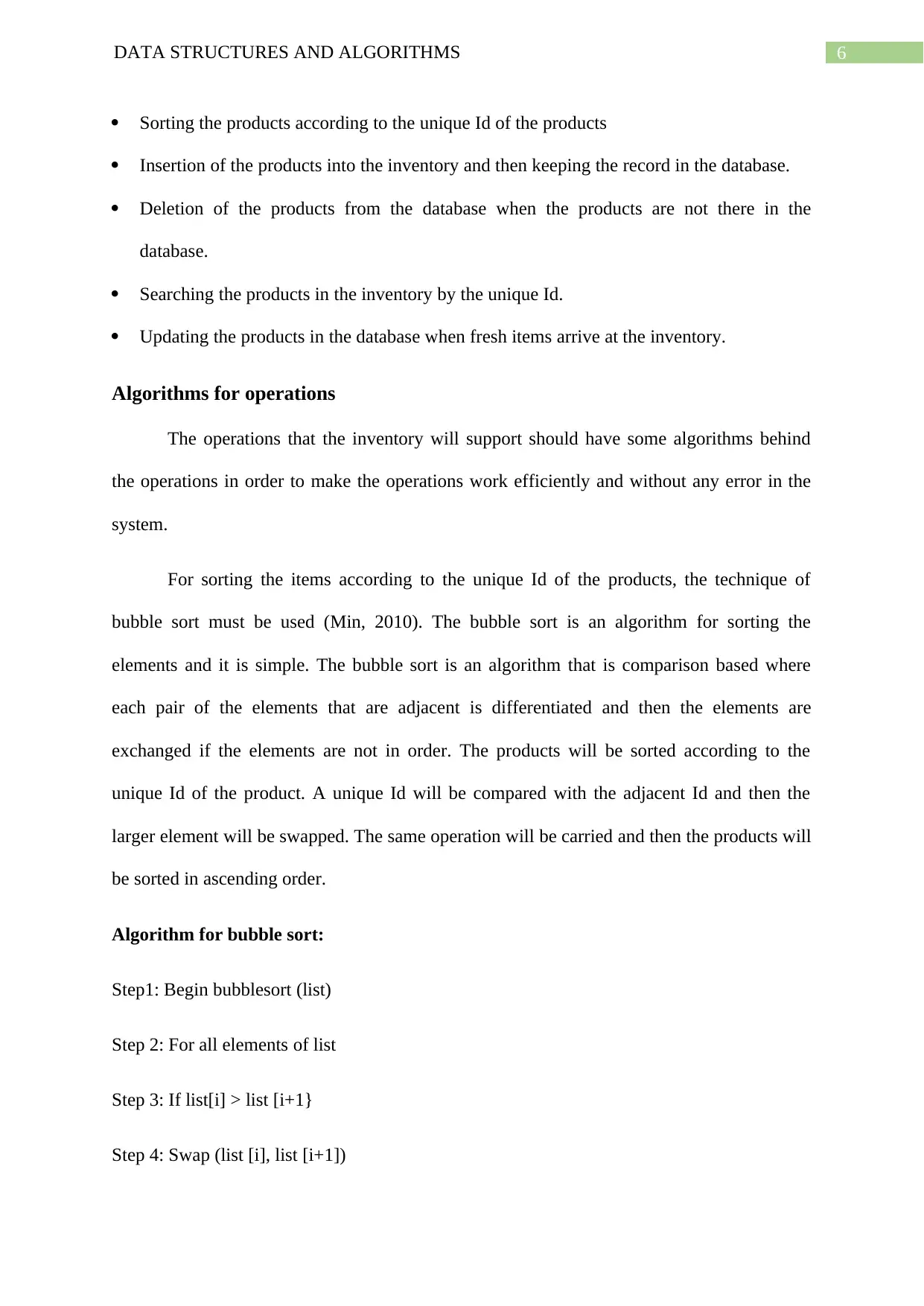
6DATA STRUCTURES AND ALGORITHMS
Sorting the products according to the unique Id of the products
Insertion of the products into the inventory and then keeping the record in the database.
Deletion of the products from the database when the products are not there in the
database.
Searching the products in the inventory by the unique Id.
Updating the products in the database when fresh items arrive at the inventory.
Algorithms for operations
The operations that the inventory will support should have some algorithms behind
the operations in order to make the operations work efficiently and without any error in the
system.
For sorting the items according to the unique Id of the products, the technique of
bubble sort must be used (Min, 2010). The bubble sort is an algorithm for sorting the
elements and it is simple. The bubble sort is an algorithm that is comparison based where
each pair of the elements that are adjacent is differentiated and then the elements are
exchanged if the elements are not in order. The products will be sorted according to the
unique Id of the product. A unique Id will be compared with the adjacent Id and then the
larger element will be swapped. The same operation will be carried and then the products will
be sorted in ascending order.
Algorithm for bubble sort:
Step1: Begin bubblesort (list)
Step 2: For all elements of list
Step 3: If list[i] > list [i+1}
Step 4: Swap (list [i], list [i+1])
Sorting the products according to the unique Id of the products
Insertion of the products into the inventory and then keeping the record in the database.
Deletion of the products from the database when the products are not there in the
database.
Searching the products in the inventory by the unique Id.
Updating the products in the database when fresh items arrive at the inventory.
Algorithms for operations
The operations that the inventory will support should have some algorithms behind
the operations in order to make the operations work efficiently and without any error in the
system.
For sorting the items according to the unique Id of the products, the technique of
bubble sort must be used (Min, 2010). The bubble sort is an algorithm for sorting the
elements and it is simple. The bubble sort is an algorithm that is comparison based where
each pair of the elements that are adjacent is differentiated and then the elements are
exchanged if the elements are not in order. The products will be sorted according to the
unique Id of the product. A unique Id will be compared with the adjacent Id and then the
larger element will be swapped. The same operation will be carried and then the products will
be sorted in ascending order.
Algorithm for bubble sort:
Step1: Begin bubblesort (list)
Step 2: For all elements of list
Step 3: If list[i] > list [i+1}
Step 4: Swap (list [i], list [i+1])
Paraphrase This Document
Need a fresh take? Get an instant paraphrase of this document with our AI Paraphraser

7DATA STRUCTURES AND ALGORITHMS
Step 5: End if
Step 6: End for
Step 7: Return list
Step 8: End bubblesort.
For insertion and deletion of products in the database of the inventory, a balanced
binary search tree should be used (Andersson, Fagerberg & Larsen, 2018). A balance binary
search tree is based on node and automatically keeps it height small that is in the face of
items that are arbitrary deletions and insertions. These are the structures that provide
implementations that are efficient for mutable lists that are ordered and it can be used for
other data structures that are abstract such as the arrays that are associative, priority queues
and sets.
Searching is one of the most important aspect of the inventory. The inventory is first
sorted in the ascending order and then the product that is required is to be searched, whether
the product is present or not (Heydari, Tajer & Poor, 2016). For searching of the product,
linear search can be used. Linear search is an algorithm for searching that is simple where a
search that is sequential is made over all the products one after the other. Every product is
examined and if a match is found then it returns the specific product and if the match is not
found, then the search goes on until the end of the products that are present in the inventory.
Algorithm for linear search:
Linear Search (Array A, value x)
Step 1: set i to 1
Step 2: if i > n then go to step 7
Step 5: End if
Step 6: End for
Step 7: Return list
Step 8: End bubblesort.
For insertion and deletion of products in the database of the inventory, a balanced
binary search tree should be used (Andersson, Fagerberg & Larsen, 2018). A balance binary
search tree is based on node and automatically keeps it height small that is in the face of
items that are arbitrary deletions and insertions. These are the structures that provide
implementations that are efficient for mutable lists that are ordered and it can be used for
other data structures that are abstract such as the arrays that are associative, priority queues
and sets.
Searching is one of the most important aspect of the inventory. The inventory is first
sorted in the ascending order and then the product that is required is to be searched, whether
the product is present or not (Heydari, Tajer & Poor, 2016). For searching of the product,
linear search can be used. Linear search is an algorithm for searching that is simple where a
search that is sequential is made over all the products one after the other. Every product is
examined and if a match is found then it returns the specific product and if the match is not
found, then the search goes on until the end of the products that are present in the inventory.
Algorithm for linear search:
Linear Search (Array A, value x)
Step 1: set i to 1
Step 2: if i > n then go to step 7

8DATA STRUCTURES AND ALGORITHMS
Step 3: if A[i] = x then go to step 6
Step 5: go to step 2
Step 6: print element x found at index i and then go to step 8
Step 7: print element not found
Step 8: Exit.
Changes for larger system
Now , the company has merged with a larger company. Together they have products
around 25,000 household items and 1500 food items. There are now more products into the
inventory and faster methods of sorting and searching techniques are required to search and
sort the elements in the inventory. The deletion and the insertion will be done the way it was
done before, when the company was smaller.
The sorting algorithm that can be used for the large company and more number of
products is merge sort (Marszałek, 2017). The merge sort is a technique of sorting that is
based on the divide and conquers method. It has a worst-case complexity of O (n log n). In
this sorting technique, the products are divided into two halves. Then one-half is divided into
another two halves and so on. The other half of the array is also divided into two parts. The
unique Id of the products is compared and they are sorted in the ascending order accordingly.
The merge sort divides the list of the products into halves that are equal until it cannot be
divided.
The algorithm of merge sort:
Step 1: if it is only one element in the record then it is already sorted, return.
Step 2: divide the records of products into two halves until it cannot be divided.
Step 3: if A[i] = x then go to step 6
Step 5: go to step 2
Step 6: print element x found at index i and then go to step 8
Step 7: print element not found
Step 8: Exit.
Changes for larger system
Now , the company has merged with a larger company. Together they have products
around 25,000 household items and 1500 food items. There are now more products into the
inventory and faster methods of sorting and searching techniques are required to search and
sort the elements in the inventory. The deletion and the insertion will be done the way it was
done before, when the company was smaller.
The sorting algorithm that can be used for the large company and more number of
products is merge sort (Marszałek, 2017). The merge sort is a technique of sorting that is
based on the divide and conquers method. It has a worst-case complexity of O (n log n). In
this sorting technique, the products are divided into two halves. Then one-half is divided into
another two halves and so on. The other half of the array is also divided into two parts. The
unique Id of the products is compared and they are sorted in the ascending order accordingly.
The merge sort divides the list of the products into halves that are equal until it cannot be
divided.
The algorithm of merge sort:
Step 1: if it is only one element in the record then it is already sorted, return.
Step 2: divide the records of products into two halves until it cannot be divided.
⊘ This is a preview!⊘
Do you want full access?
Subscribe today to unlock all pages.

Trusted by 1+ million students worldwide

9DATA STRUCTURES AND ALGORITHMS
Step 3: merge the smaller list into new list that is in the sorted order.
For insertion and deletion of products in the database of the inventory, a balanced
binary search tree should be used (Philipp, Tarrataca & Boettcher, 2016). A balance binary
search tree is a binary search tree that is based on node and automatically keeps it height
small that is in the face of items that are arbitrary deletions and insertions. These are the
structures that provide implementations that are efficient for mutable lists that are ordered
and it can be used for other data structures that are abstract such as the arrays that are
associative, priority queues and sets.
For searching of the products in the larger company, binary search can be used.
Binary search also works on divide and conquer method (Friedman, 2018). The lists of the
products are divided into two halves and then the products are searched in the first half of the
list. If the product is found in the first half then it does not search the second half. If the
product is not found in the first half, then the second half of the list is searched. If the product
is found then the product is returned else, then it returns nothing. This sort can be done on
large number of elements and it is fast (Alsuwaiyel, 2016).
Conclusion
The report concludes with the inventory of the larger system and the searching and
sorting algorithms that are used for the larger system. The report deals with the designing of
an inventory system. The report focuses on the keys, variables and the ranges that are used in
the system. The report discusses about the operations that the inventory will support. The
report has a detailed discussion about the algorithms that will help the company in its
operations and last but not the least, the report focuses on the changes in the original system
when the company has merged with a larger company. For the large company there should be
a change in the algorithms as the items are more than the smaller company is.
Step 3: merge the smaller list into new list that is in the sorted order.
For insertion and deletion of products in the database of the inventory, a balanced
binary search tree should be used (Philipp, Tarrataca & Boettcher, 2016). A balance binary
search tree is a binary search tree that is based on node and automatically keeps it height
small that is in the face of items that are arbitrary deletions and insertions. These are the
structures that provide implementations that are efficient for mutable lists that are ordered
and it can be used for other data structures that are abstract such as the arrays that are
associative, priority queues and sets.
For searching of the products in the larger company, binary search can be used.
Binary search also works on divide and conquer method (Friedman, 2018). The lists of the
products are divided into two halves and then the products are searched in the first half of the
list. If the product is found in the first half then it does not search the second half. If the
product is not found in the first half, then the second half of the list is searched. If the product
is found then the product is returned else, then it returns nothing. This sort can be done on
large number of elements and it is fast (Alsuwaiyel, 2016).
Conclusion
The report concludes with the inventory of the larger system and the searching and
sorting algorithms that are used for the larger system. The report deals with the designing of
an inventory system. The report focuses on the keys, variables and the ranges that are used in
the system. The report discusses about the operations that the inventory will support. The
report has a detailed discussion about the algorithms that will help the company in its
operations and last but not the least, the report focuses on the changes in the original system
when the company has merged with a larger company. For the large company there should be
a change in the algorithms as the items are more than the smaller company is.
Paraphrase This Document
Need a fresh take? Get an instant paraphrase of this document with our AI Paraphraser
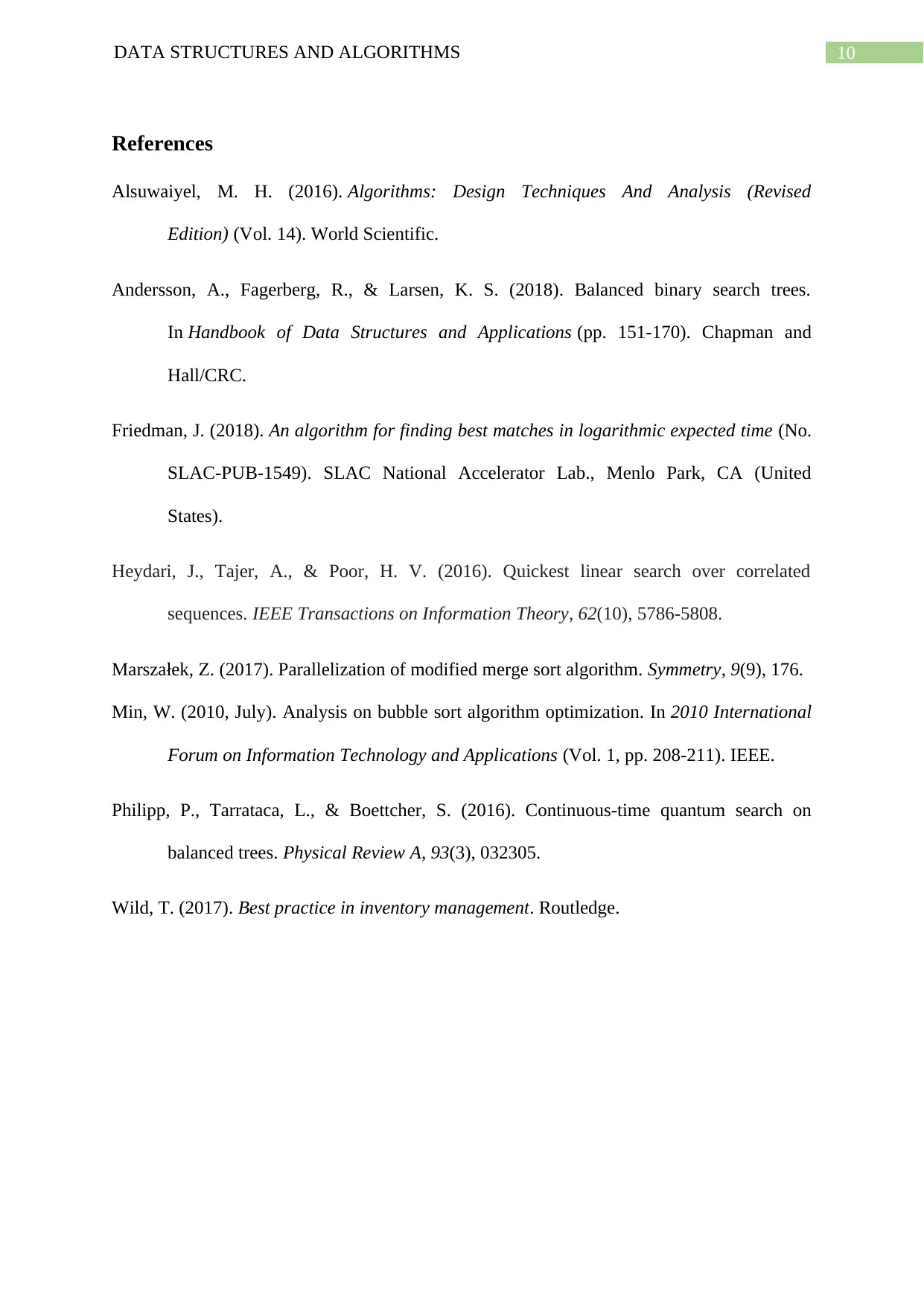
10DATA STRUCTURES AND ALGORITHMS
References
Alsuwaiyel, M. H. (2016). Algorithms: Design Techniques And Analysis (Revised
Edition) (Vol. 14). World Scientific.
Andersson, A., Fagerberg, R., & Larsen, K. S. (2018). Balanced binary search trees.
In Handbook of Data Structures and Applications (pp. 151-170). Chapman and
Hall/CRC.
Friedman, J. (2018). An algorithm for finding best matches in logarithmic expected time (No.
SLAC-PUB-1549). SLAC National Accelerator Lab., Menlo Park, CA (United
States).
Heydari, J., Tajer, A., & Poor, H. V. (2016). Quickest linear search over correlated
sequences. IEEE Transactions on Information Theory, 62(10), 5786-5808.
Marszałek, Z. (2017). Parallelization of modified merge sort algorithm. Symmetry, 9(9), 176.
Min, W. (2010, July). Analysis on bubble sort algorithm optimization. In 2010 International
Forum on Information Technology and Applications (Vol. 1, pp. 208-211). IEEE.
Philipp, P., Tarrataca, L., & Boettcher, S. (2016). Continuous-time quantum search on
balanced trees. Physical Review A, 93(3), 032305.
Wild, T. (2017). Best practice in inventory management. Routledge.
References
Alsuwaiyel, M. H. (2016). Algorithms: Design Techniques And Analysis (Revised
Edition) (Vol. 14). World Scientific.
Andersson, A., Fagerberg, R., & Larsen, K. S. (2018). Balanced binary search trees.
In Handbook of Data Structures and Applications (pp. 151-170). Chapman and
Hall/CRC.
Friedman, J. (2018). An algorithm for finding best matches in logarithmic expected time (No.
SLAC-PUB-1549). SLAC National Accelerator Lab., Menlo Park, CA (United
States).
Heydari, J., Tajer, A., & Poor, H. V. (2016). Quickest linear search over correlated
sequences. IEEE Transactions on Information Theory, 62(10), 5786-5808.
Marszałek, Z. (2017). Parallelization of modified merge sort algorithm. Symmetry, 9(9), 176.
Min, W. (2010, July). Analysis on bubble sort algorithm optimization. In 2010 International
Forum on Information Technology and Applications (Vol. 1, pp. 208-211). IEEE.
Philipp, P., Tarrataca, L., & Boettcher, S. (2016). Continuous-time quantum search on
balanced trees. Physical Review A, 93(3), 032305.
Wild, T. (2017). Best practice in inventory management. Routledge.
1 out of 11
Related Documents
Your All-in-One AI-Powered Toolkit for Academic Success.
+13062052269
info@desklib.com
Available 24*7 on WhatsApp / Email
![[object Object]](/_next/static/media/star-bottom.7253800d.svg)
Unlock your academic potential
Copyright © 2020–2025 A2Z Services. All Rights Reserved. Developed and managed by ZUCOL.





